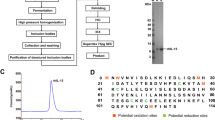Abstract
Recombinant human interleukin 11 (rhIL-11) is a multispectrum cytokine that plays an important role in megakaryocytopoiesis and platelet production. Probing rhIL-11 chemical reactivity in aqueous solution is an important initial step in developing a dosage form for rhIL-11 clinical trials. This report documents rhIL-11 degradation kinetics at 50°C in solutions adjusted to pH 3.0 to 9.5. Stressed samples were analyzed by reverse-phase HPLC and degradation product peaks were isolated for structural characterization. The results show maximal stability in the region pH 6.5 to 7.0. Degradation product identification shows that the major reaction pathway in acidic solution involves peptide cleavage at aspartate133–proline134. In alkaline solution, protein disappearance proceeds via nonspecific loss to container surfaces. Degradation products at alkaline pH have not been identified.
Similar content being viewed by others
REFERENCES
S. C. Clark and R. Kamen. The human hematopoietic colony-stimulating factors. Science 236:1229–1236 (1987).
Y.-C. Yang and T. Yin. Interleukin-11 and its receptor. Biofactors 4:15–21 (1992).
S. R. Paul, F. Bennet, J. A. Calvetti, K. Kelleher, C. R. Wood, R. M. O'Hara, A. C. Leary, B. Sibley, S. C. Clark, D. A. Williams, and Y.-C. Yang. Molecular cloning of a cDNA encoding interleukin 11, a stromal cell-derived lymphopoeitic and hematopoietic cytokine. Proc. Natl. Acad. Sci. USA 87:7512–7516 (1990).
M. Musashi, Y.-C. Chang, S. R. Paul, S. C. Clark, T. Sudo, and M. Ogawa. Proc. Natl. Acad. Sci. USA 88:765–769 (1991).
M. Teramura, S. Kobayashi, S. Hoshino, K. Oshimi, and H. Mizoguchi. Interleukin 11 enhances human megakaryocytopoiesis in vitro. Blood 79:327–331 (1992).
S. Goldman, T. Neben, J. Lobelenz, K. McCarthy, J. B. Stoudemire, and R. G. Schaub. Recombinant human interleukin-11 stimulates megakaryocytopoiesis and increases in periperal platelet number in normal and splenectomized mice. J. Cell. Biochem. 16C:74–80 (1992).
A. Bree, F. Schlerman, G. Timonoy, K. McCarthy, and J. Stoudemire. Pharmacokinetics and thrombopoietic effects of recombinant human interleukin-11 in nonhuman primates and rodents. Blood 78:132a (1991).
R. C. Wood, S. R. Paul, S. Goldman, M. Muench, R. Palmer, G. Pedneault, G. E. Morris, A. Bree, L. Hayes, J. Hoysradt, R. Schaub, M. A. S. Moore, and S. C. Clark. IL-11 expression in donor bone marrow cells improves hematological reconstitution in lethally irradiated recipient mice. J. Cell. Biochem. 16C:93–97 (1992).
J. Geigert. Overview of the stability and handling of recombinant protein drugs. J. Parent. Sci. Technol. 43:220–224 (1989).
M. J. Pikal, K. M. Dellerman, M. L. Roy, and R. M. Riggin. The effects of formulations variables on the stability of freezedried human growth hormone. Pharm. Res. 8:427–436 (1991).
W. Jiskoot, E. C. Beuvery, A. A. M. de Koning, J. N. Herron, and D. J. A. Crommelin. Analytical approaches to the study of monoclonal antibody stability. Pharm. Res. 7:1234–1241 (1990).
G. C. Visor, V. M. Knepp, K. P. Tsai, M. D. Miller, J. Duffey, T. Calderwood, D. Lokensgard, J. Killian, T. Malefyt, L. Gu, and I. Massey. Development and characterization of a lyophilized dosage form of IL-1β. Lymph. Res. 9:425–434 (1990).
P. Labrude and C. Vigneron. Stability and functional properties of haemoglobin freeze-dried in the presence of four protective substances after prolonged storage: Dose-effect relationships. J. Pharm. Pharacol. 35:23–27 (1982).
J. Geigert, B. M. Panshcar, S. Fong, H. N. Huston, D. E. Wong, D. Y. Wong, C. Tanford and M. Pemberton. The long-term stability of recombinant (serine-17) human interferon-β. J. Inter. Res. 8:539–547 (1988).
J. Geigert, B. M. Panschar, C. Taforo, J. Paola, S. Fong, H. N. Huston, D. E. Wong, and D. Y. Wong. Parameters for the evaluation of long-term stability of tumour necrosis factor preparations. Dev. Biol. Stand. 69:129–138 (1988).
E. Watson and W. C. Kenney. High-performance size-exclusion chromatography of recombinant derived proteins and aggregated species. J. Chromatogr. 436:289–298 (1988).
K. C. Lee, Y. J. Lee, H. M. Song, S. J. Chung, and P. P. DeLuca. Degradation of synthetic salmon calcitonin in aqueous solution. Pharm. Res. 9:1521–1523 (1992).
D. J. Kroon, A. Baldwin-Ferro, and P. Lalan. Identification of sites of degradation in a therapeutic monoclonal antibody by peptide mapping. Pharm. Res. 9:1386–1393 (1992).
J. Brange, L. Langkjaer, S. Havelund, and A. Volund. Chemical stability of insulin. 1. Hydrolytic degradation during storage of pharmaceutical preparations. Pharm. Res. 9:715–726 (1992).
J. Brange, S. Havelund, and P. Hougaard. Chemical stability of insulin. 2. Formation of higher molecular weight transformation products during storage of pharmaceutical preparations. Pharm. Res. 9:727–734 (1992).
B. M. Eckhardt, J. Q. Oeswein, and T. A. Bewley. Effect of freezing on aggregation of human growth hormone. Pharm. Res. 8:1360–1364 (1991).
S. Shire. pH dependent polymerization of a human leukocyte interferon produced by recombinant deoxyribonucleic acid technology. Biochemistry 22:2664–2671 (1983).
J. A. Schrier, R. A. Kenley, R. Williams, R. J. Corcoran, Y. Kim, R. P. Northey, D. D'Augusta, and M. Huberty. Degradation pathways for recombinant human macrophage colony-stimulating factor in aqueous solution. Pharm. Res. 10:933–944 (1993).
M. C. Manning, K. Patel, and R. T. Borchardt. Stability of protein pharmaceuticals. Pharm. Res. 6:903–917 (1989).
V. V. Mozhaev, I. V. Berezin, and K. Martinek. Structurestability relationship in proteins. CRC Crit. Rev. Biochem. 23:235–282 (1988).
J. Q. Oeswein and S. J. Shire. Physical biochemistry of protein drugs. In V. H. L. Lee (ed.), Peptide and Protein Drug Delivery, Marcel Dekker, New York, 1991, pp. 167–202.
M. Landon. Cleavage at aspartyl-proline bonds. Methods Enzymol. 47:145–57 (1977).
D. Piszkiewicz, M. Landon, and E. L. Smith. Anomolous cleavage of aspartyl-proline peptide bonds during amino acid sequence determination. Biochem. Biophys. Res. Comm. 40:1173–1178 (1970).
A. S. Ingliss. Cleavage at aspartic acid. Methods Enzymol. 91:324–332 (1983).
K. Patel and R. T. Borchardt. Chemical pathways of peptide degradation. II. Pharm. Res. 7:703–711 (1990).
Author information
Authors and Affiliations
Rights and permissions
About this article
Cite this article
Kenley, R.A., Warne, N.W. Acid-Catalyzed Peptide Bond Hydrolysis of Recombinant Human Interleukin 11. Pharm Res 11, 72–76 (1994). https://doi.org/10.1023/A:1018945727640
Issue Date:
DOI: https://doi.org/10.1023/A:1018945727640




